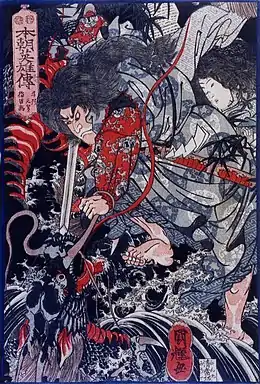Ukemochi
Ōgetsu-hime (大宜都比売神/ 大気都比売神/ 大宜津比売神/ 大気津比売神, Ōgetsu-hime/ Ohogetsu-hime-no-kami), commonly known as Ukemochi (Japanese: 保食神, Hepburn: Ukemochi-no-kami, English: "Goddess Who Protects Food"), the daughter of the Shinto deities Izanagi and Izanami, is a goddess of food in the Shinto religion of Japan.[1] Different interpretations of Ukemochi often refer to them as both male and female. When shown in other forms, Ukemochi takes the shape of a fox.[2] Ōgetsu-hime is the wife of Hayamato (羽山戸神, Hayamato-no-kami), who is the son of Toshigami through his wife Amechikarumizu-hime (天知迦流美豆比売) in the Kojiki. In some legends, Ukemochi is also the wife of Inari[3] and in others, she is Inari.
When Ukemochi (Ōgetsu-hime) was visited by Tsukuyomi, she prepared a feast by facing the ocean and spitting out a fish, then she faced the forest and bountiful game spewed out of her mouth,[4] finally turning to a rice paddy, she coughed up a bowl of rice. In the Kojiki,[5] it is stated that she pulled various foods from within her nose, rectum, and mouth to prepare a feast. Tsukuyomi was so disgusted he killed her.[6] Her dead body also produced food: millet, rice seeds, wheat, and beans sprang forth.[5][7][8] Out of her eyebrows came silkworms.[9] While different sources mention similar items that came from Ukemochi's body, from which part of her body these items came from is less agreed upon.
In some narratives of Ukemochi, after her death Tsukuyomi finds that the food that came from her body could not be destroyed. He takes the grains and animals that came from Ukemochi's body and gives them new life.[2] This new life was put under Inari's jurisdiction.[2] It is believed that Ukemochi's death explained why the sun and the moon are not seen together as the sun goddess, Amaterasu, who heard of Ukemochi's passing, never wanted to meet her killer, the moon god, Tsukuyomi, again.[10]
In addition, in a legend passed down in Iwami district (石見地方) in Shimane Prefecture (島根県), her daughter and deity Otogosa-hime (乙子狭姫) rode on a red goose and descended to transmit the seeds of the crops to the ground. Otogosa-hime was able to get food from anywhere on her body.
Ukemochi, Inari, and Toyouke are all said to be connected to each other.[11]
See also
References
- Loar, Julie (2010). Goddesses for Every Day: Exploring the Wisdom and Power of the Divine Feminine around the World. New World Library. p. 269. ISBN 978-1-57731-950-4.
- McLeish, Kenneth (1996). Myth: myths & legends of the world explored. London: Bloomsbury. ISBN 0-7475-2502-1. OCLC 233541565.
- Hathaway, Nancy (2003). The Friendly Guide to Mythology: A Mortal's Companion to the Fantastical Realm of Gods, Goddesses, Monsters, and Heroes. Penguin Group. p. 129. ISBN 978-0-140-24087-0.
- Obayashi, Taryo (September 1, 1977). "The Structure of the Pantheon and the Concept of Sin in Ancient Japan". Diogenes. 25 (98): 117–132. doi:10.1177/039219217702509806. ISSN 0392-1921. S2CID 144561509.
- Kojiki. Philippi, Donald L. [Princeton, N.J.]: Princeton University Press. 1969. ISBN 978-1-4008-7800-0. OCLC 557011276.CS1 maint: others (link)
- Mittal, Nemi (1993). World-Famous Mythologies. Pustak Mahal. pp. 96–97. ISBN 81-223-0548-2.
- Heine, Steven (1991). "From Rice Cultivation to Mind Contemplation: The Meaning of Impermanence in Japanese Religion". History of Religions. 30 (4): 373–403. doi:10.1086/463247. ISSN 0018-2710. JSTOR 1062774. S2CID 170092061.
- Nicolae, Raluca (June 1, 2011). "The Japanese legend as an interdisciplinary narrative". Economics, Management, and Financial Markets. 6 (2).
- Walker, Brett L. (January 2007). "Sanemori's Revenge: Insects, Eco-System Accidents, and Policy Decisions in Japan's Environmental History". Journal of Policy History. 19 (1): 113–144. doi:10.1353/jph.2007.0007. ISSN 1528-4190. S2CID 154533956.
- "Ukemochi no Kami | Shintō goddess". Encyclopedia Britannica. Retrieved 2019-12-14.
- Monaghan, Patricia. (2010). Encyclopedia of goddesses and heroines. Santa Barbara, Calif.: Greenwood. ISBN 978-0-313-34990-4. OCLC 606742611.
External links
- Encyclopedia of Shinto - http://eos.kokugakuin.ac.jp
- Ukemochi on the Japanese History Database.

